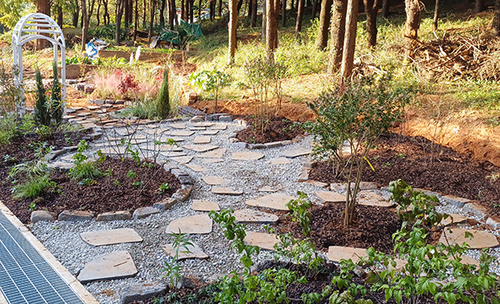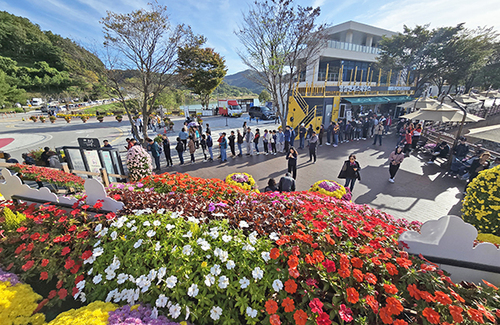| ▲ 가야문화확산 발굴 및 정비사업 일환으로 추진된 '당산리 산성ㆍ봉화 유적 시굴조사' 결과, 가 무주국유림관리소 산불종합훈련장이 위치한 해발 400m의 야산 정상부를 둘러싼 석축과 봉화로 추정되는 석축시설을 확인돼 전북 무주가 당시 접경 지역으로 영토 확장을 위한 요충지로 추정됐다. / 사진제공 = 무주군청 © 김현종 기자 |
|
가야문화확산 발굴 및 정비사업 일환으로 추진된 '당산리 산성ㆍ봉화 유적 시굴조사'가 마무리된 가운데 전북 무주가 당시 접경 지역으로 영토 확장을 위한 요충지로 추정됐다.
무주군은 "군산대 가야문화연구소 자문을 받아 당산리 산성ㆍ봉화유적에 대한 현지검토를 실시한 결과, 무주국유림관리소 산불종합훈련장이 위치한 해발 400m의 야산 정상부를 둘러싼 석축과 봉화로 추정되는 석축시설을 확인했다"고 30일 밝혔다.
특히 지난해 10월 실시한 정밀지표조사 결과, 산의 능선을 따라 분포하고 있는 3기의 봉화대(봉화추정지)와 봉화대 주변에 부분적으로 조성된 성벽(석축방호벽)이 확인돼 전북 동부지역 유적의 성격을 파악하는데 중요한 자료로 평가되고 있다.
이번 시굴조사 결과, 봉화대로 추정되는 동-서 약 6.9mㆍ남-북 약 7m의 정방형에 가까운 석축시설의 구조와 형태가 확인됐고 석축시설 아래에 석축을 보강하기 위해 계단식으로 쌓은 보축부가 일부 남아 있는 것이 확인됐다.
봉화시설 축조는 거칠게 다듬은 석재를 허튼쌓기(크기가 다른 돌들을 줄눈을 맞추지 않고 불규칙하게 쌓는 방법) 방식으로 축조한 것으로 파악됐으며 상부로 갈수록 면석을 들여쌓아 안정성을 준 점이 특징이다.
또 삼국~통일신라시대의 것으로 추정되는 토기편이 소량 확인됐다.
무주군 김정미 문화체육과장은 "무주는 삼도봉을 비롯 4개의 도(道) 경계를 이루고 있는 지역으로 2020년 발굴된 무주 용포리 노고산 봉화유적과 이번에 확인된 당산리 봉화유적은 과거 주계고성을 중심으로 무주 일원은 당시 접경지역으로 삼국~통일신라시대 영토(세력)확장을 위한 요충지였음을 반증해주고 있다"고 설명했다.
그러면서 "그동안 발굴 성과를 토대로 무주 지역의 실체를 밝혀내기 위한 추가 조사 및 학술대회 개최 등을 추진해 문화재 지정을 목표로 유적들이 체계적으로 보존과 관리가 이뤄질 수 있도록 최선의 노력을 다하겠다"고 덧붙였다.
한편, 백제 진례현에서부터 고려 공양왕 3년까지 행정치소로만 알려졌던 주계(무주읍 일원)고성 터에서 통일신라시대 기와 편들이 다수 확인되는 등 주계고성과 인접한 곳에 위치한 대차리 고분군의 발굴조사(2018)에서도 신라 유물들이 다수 확인됐다.
지난 19일 열린 학술자문회의에서 '단순히 백제영역으로만 인식됐던 주계(무주읍 일원)와 신라영역으로 알려져 왔던 무산(무풍면 일원)이라는 시대상에 대해 인식의 재고 및 봉화유적의 정확한 구조와 당시 봉화를 운영했던 이들의 생활시설 등을 파악하기 위한 추가 발굴조사가 필요하고 이를 통해 봉화유적의 성격을 규명해 보존 및 관리를 위한 문화재 지정이 필요하다'는 의견이 모아졌다.
☞ 아래는 위 기사를 구글 번역이 번역한 영문 기사의 '전문' 입니다.
구글 번역은 이해도를 높이기 위해 노력하고 있으며 영문 번역에 오류가 있음을 전제로 합니다.
【Below is the 'full text' of the English article translated by Google Translate.
Google Translate is working hard to improve understanding, and assumes that there are errors in the English translation.】
Prospecting completed at Muju 'Dangsan-ri Fortress/Bonghwa Remains'
400m above sea level… Confirmation of the 'stone protection wall' built around Bonghwadae
Reporter Ga-young Kim
As the 'Dangsan-ri Fortress/Bonghwa Remains Prospecting Survey', which was carried out as part of the excavation and maintenance project for the spread of Gaya culture, was completed, Muju, Jeollabuk-do was estimated to be a key point for territorial expansion to the border area at the time.
Muju-gun said, "As a result of conducting an on-site review of the Dangsan-ri fortress and Bonghwa ruins with the advice of the Gaya Culture Research Institute at Gunsan University, we confirmed the stonework surrounding the top of the 400m-high mountain range where the Muju National Forest Management Center is located and the stonework facility presumed to be a beacon." said on the 30th.
In particular, as a result of a detailed index survey conducted in October of last year, three Bonghwadae (Bonghwachujeong) and fortress walls (stone-axis protection walls) partially built around Bonghwadae were identified, which were distributed along the ridge of the mountain, to understand the nature of the ruins in the eastern part of Jeollabuk-do. It is regarded as an important data for.
As a result of this trial excavation, the structure and shape of the stone-construction facility, which is estimated to be approximately 6.9m east-west and 7m north-south, estimated to be Bonghwadae, was confirmed. It has been confirmed that there is
The construction of the Bonghwa facility was found to have been constructed using coarsely polished stones (a method of stacking stones of different sizes irregularly without matching joints), and it is characterized by indenting the faces toward the top to provide stability.
In addition, a small amount of earthenware fragments presumed to be from the Three Kingdoms to Unified Silla period have been identified.
Kim Jeong-mi, director of culture and sports in Muju-gun, said, "Muju is an area bordering four provinces including Samdobong. As a border area, it proves that it was a key point for the expansion of the territory (force) between the Three Kingdoms and the Unified Silla period,” he explained.
He added, "Based on the excavation results, we will do our best to systematically preserve and manage the ruins with the goal of designating cultural assets by conducting additional investigations and holding academic conferences to uncover the reality of the Muju area."
On the other hand, in the excavation survey (2018) of the Daechari Tombs located adjacent to Jugye Old Fortress, such as a large number of tiles in the Unified Silla period were found at the site of the Goseong of Jugye (Muju-eup), which was known only as an administrative prison from Jinrye-hyeon of Baekje to the 3rd year of King Gongyang of Goryeo, Silla also Many artifacts have been identified.
At the academic advisory meeting held on the 19th, a reconsideration of awareness about the era of Jugye (Muju-eup area), which was simply recognized as the Baekje area, and Musan (Mupung-myeon area), which was known as the Silla area, and the precise structure of the Bonghwa site and operation of the beacon at that time An opinion was gathered that additional excavation and investigations are needed to identify the living facilities of those who used to live there, and through this, it is necessary to identify the characteristics of the Bonghwa ruins and designate cultural assets for preservation and management.





















 많이 본 뉴스
많이 본 뉴스











